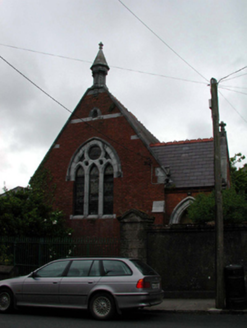Survey Data
Reg No
22809174
Rating
Regional
Categories of Special Interest
Architectural, Artistic, Social
Original Use
Church/chapel
In Use As
Church/chapel
Date
1875 - 1895
Coordinates
204939, 98449
Date Recorded
06/10/2003
Date Updated
--/--/--
Description
Detached four-bay single-storey red brick Presbyterian church, c.1885, with single-bay single-storey side (south) elevation, and single-bay single-storey lower porch to south-east. Pitched slate roofs with decorative red clay ridge tiles, cut-limestone coping having polygonal finial to apex to south with colonette detailing, frieze, polygonal capping and acorn finial, finial to apex to porch, and cast-iron rainwater goods on moulded red brick eaves. Red brick English Garden Wall bond walls with red brick buttresses having cut-limestone coping, and limestone ashlar stringcourse to gable. Lancet window openings to gable in tripartite arrangement having oculus over forming pointed-arch arrangement with cut-limestone chamfered sills, mullions, voussoirs, and hood moulding over having mask/portrait consoles. Fixed-pane leaded stained glass panels. Pointed arch door opening with cut-limestone surround having moulded reveals, hood moulding over, and tongue-and-groove timber panelled door. Set back from line of road in own grounds with forecourt having sections of wrought iron railings on unpainted rendered plinth with spear-head finials, wrought iron gate, and unpainted rendered rusticated piers with profiled capping.
Appraisal
An appealing small-scale church that is of particular significance as a reminder of the Presbyterian community in Lismore. Well maintained, the church retains most of the original form and fabric to the exterior. The construction in red brick is a distinguishing feature in the streetscape, while the cut-limestone dressings produce an attractive textured and somewhat polychromatic visual effect. Some carved stone detailing, together with the stained glass panels to the window openings, enhance the artistic quality of the design. The church remains a picturesque feature in the street scene, the early-surviving wrought iron railings to the forecourt enhancing the historic quality of the site.

